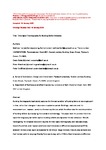Time-lapse thermography for building defect detection
| dc.contributor.author | Fox, Matthew | |
| dc.contributor.author | Coley, D | |
| dc.contributor.author | Goodhew, Steve | |
| dc.contributor.author | de Wilde, Pieter | |
| dc.date.accessioned | 2017-04-19T11:29:58Z | |
| dc.date.available | 2017-04-19T11:29:58Z | |
| dc.date.issued | 2015-04 | |
| dc.identifier.issn | 0378-7788 | |
| dc.identifier.issn | 1872-6178 | |
| dc.identifier.other | 0 | |
| dc.identifier.uri | http://hdl.handle.net/10026.1/9089 | |
| dc.description.abstract |
Building thermography traditionally captures the thermal condition of building fabric at one single point in time, rather than changes in state over a sustained period. Buildings, materials and the environment are, however, rarely in a thermal equilibrium, which therefore risks the misinterpretation of building defects by employing this standard methodology. This paper tests the premise that time-lapse thermography can better capture building defects and dynamic thermal behaviour. Results investigating the temporal resolution required for time-lapse thermography over two case study houses found that under typical conditions small temperature differences (approximately 0.2 K) between thermal areas could be expected for 30-min image intervals. Results also demonstrate that thermal patterns vary significantly from day-to-day, with a 2.0 K surface temperature difference experienced from one day to the next. Temporal resolutions needed adjusting for different types of construction. Time-lapse experiments raised practical limitations for the methodology that included problems with the distance to target and foreground obstructions. At the same time, these experiments show that time-lapse thermography could greatly improve our understanding of building transient behaviour and possible building defects. Time-lapse thermography also enables enhanced differentiation between environmental conditions (such as clear sky reflections), actual behaviour and construction defects, thereby mitigating the risk of misinterpretation. | |
| dc.format.extent | 95-106 | |
| dc.language | en | |
| dc.language.iso | en | |
| dc.publisher | Elsevier BV | |
| dc.subject | Time-lapse thermography | |
| dc.subject | Transient behaviour | |
| dc.subject | Defect detection | |
| dc.title | Time-lapse thermography for building defect detection | |
| dc.type | journal-article | |
| dc.type | Journal Article | |
| plymouth.author-url | https://www.webofscience.com/api/gateway?GWVersion=2&SrcApp=PARTNER_APP&SrcAuth=LinksAMR&KeyUT=WOS:000351786900009&DestLinkType=FullRecord&DestApp=ALL_WOS&UsrCustomerID=11bb513d99f797142bcfeffcc58ea008 | |
| plymouth.volume | 92 | |
| plymouth.publication-status | Published | |
| plymouth.journal | Energy and Buildings | |
| dc.identifier.doi | 10.1016/j.enbuild.2015.01.021 | |
| plymouth.organisational-group | /Plymouth | |
| plymouth.organisational-group | /Plymouth/Faculty of Arts, Humanities and Business | |
| plymouth.organisational-group | /Plymouth/Faculty of Arts, Humanities and Business/School of Art, Design and Architecture | |
| plymouth.organisational-group | /Plymouth/REF 2021 Researchers by UoA | |
| plymouth.organisational-group | /Plymouth/REF 2021 Researchers by UoA/UoA13 Architecture, Built Environment and Planning | |
| plymouth.organisational-group | /Plymouth/Users by role | |
| plymouth.organisational-group | /Plymouth/Users by role/Academics | |
| dcterms.dateAccepted | 2015-01-18 | |
| dc.rights.embargodate | 2016-04-01 | |
| dc.identifier.eissn | 1872-6178 | |
| dc.rights.embargoperiod | 12 months | |
| rioxxterms.versionofrecord | 10.1016/j.enbuild.2015.01.021 | |
| rioxxterms.licenseref.uri | http://www.rioxx.net/licenses/under-embargo-all-rights-reserved | |
| rioxxterms.licenseref.startdate | 2015-04 | |
| rioxxterms.type | Journal Article/Review |


